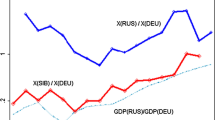Abstract
New Borders: Evidence from the Former Soviet Union. — We study the effects of trade barriers and the persistence of past linkages on trade flows in the former Soviet Union (FSU). Estimating a gravity equation on 1987–1996 trade between nine Russian regions and fourteen FSU republics, we find that Russian regions traded nearly twice as much with each other as with republics in the reform period (1994–1996). In contrast, they did not trade significantly more with each other than with republics in the prereform period (1987–1990). Our results suggest that the bias towards domestic trade in the reform period is primarily a result of tariffs. We also find that past linkages, such as infrastructure, production and consumption chains, and business networks, have limited the reorientation of trade.
Similar content being viewed by others
References
Aturupane, C., S. Djankov, and B. Hoekman (1999). Horizontal and Vertical Intra-Industry Trade between Eastern Europe and the European Union.Weltwirtschaftliches Archiv 135 (1): 62–81.
Bougheas, S., P. Demetriades, and E. Morgenroth (1999). Infrastructure, Transport Costs, and Trade.Journal of International Economics 47 (1): 169–189.
de Menil, G., and M. Maurel (1994). Breaking up a Customs Union: The Case of the Austro-Hungarian Empire in 1919.Weltwirtschaftliches Archiv 130 (3): 553–575.
Deardorff, A. (1998). Determinants of Bilateral Trade: Does Gravity Work in a Neoclassical World? In J. Frankel (ed.),The Regionalization of the World Economy. Cambridge, Mass.: NBER.
Djankov, S., and C. Freund (2002). Trade Flows in the Former Soviet Union, 1987–1996.Journal of Comparative Economics 30 (1): 76–90.
Eichengreen, B., and D. Irwin (1998). The Role of History in Bilateral Trade Flows. In J. Frankel (ed.),The Regionalization of the World Economy. Cambridge, Mass.: NBER.
Engel, C., and J. Rogers (1996). How Wide Is the Border?American Economic Review 86(5): 1112–1125.
Frankel, J. (1997).Regional Trading Blocs. Washington, D.C.: Institute for International Economics.
Frankel, J., E. Stein, and S. Wei (1995). Trading Blocs and the Americas: The Natural, the Unnatural, and the Super-Natural.Journal of Development Economics 47 (1): 61–95.
Freund, C. (2000). Different Paths to Free Trade: The Gains from Regionalism.Quarterly Journal of Economics 115 (4): 1317–1341.
Helliwell, J. (1998).How Much Do National Borders Matter? Washington, D.C.: Brookings Institution Series on Integrating National Economies.
Maurel, M., and G. Cheikbossian (1998). The New Geography of Eastern European Trade.Kyklos 51 (1): 45–71.
McCallum, J. (1995). National Borders Matter: Canada-U.S. Regional Trade Patterns.American Economic Review 85 (3): 615–623.
Ministry of Transport of the USSR (1990). The Drivers’ Guide of the Soviet Union. Moscow.
State Statistical Committee of the Russian Federation (1993, 1997). Russian Statistical Yearbook. Moscow.
Wei, S. (1996). Intra-national Versus International Trade: How Stubborn Are Nations in Global Integration? NBER Working Paper 5531. Cambridge, Mass.
Wonnacott, P. (1998). Comment. In J. Frankel (ed.),The Regionalization of the World Economy. Cambridge, Mass.: NBER.
World Bank (1992, 1993, 1994, 1996). Foreign Trade Statistics of the Soviet Union and Its Successor Countries. Washington, D.C.




